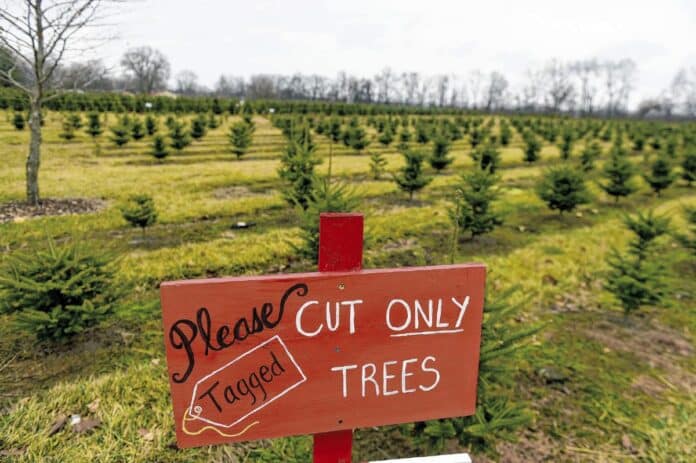
GREENFIELD — Most Hancock County Christmas tree farms shuttered early this year due to a “perfect storm” of tight supply, a short selling window and the lingering effects of a drought seven years ago.
Experts, however, say demand remains strong, although the market for fresh, choose-and-cut trees was hit significantly by the Great Recession of 2008, which drove buyers to less expensive, reusable artificial trees.
Almost 33 million trees sold nationally last year, according to the National Christmas Tree Association, up from 27.4 million trees cut in 2017.
[sc:text-divider text-divider-title=”Story continues below gallery” ]
Additionally, younger buyers seeking new experiences and traditions along with a bid to support local agriculture are driving a renewed push to cut and drag a tree out of the stand, according to a study by Indiana University’s O’Neill School of Public and Environmental Affairs.
So with such strong demand, why did two of Hancock County’s three tree farms close early this year? Sambol’s Tree Farm and Lost 40 Tree Farm, both near Maxwell, stopped selling before mid-December, which is usually the heart of tree-cutting season.
“We had a shortage of the right-sized tree,” said Kathy Wendt, who has been running Lost 40 Tree Farm with husband Bob for 30 years. “We couldn’t decide whether to stay closed entirely this year, but we opted to open for one weekend.”
Sambol’s Tree farm closed for the season Dec. 13.
Daniel Cassens, professor emeritus at Purdue University’s Department of Forestry and Natural Resources, who also owns tree farms in West Lafayette and Delphi, said this year’s late Thanksgiving saddled growers with a narrow window from the outset.
Traditionally, tree farmers begin selling the day after Thanksgiving and run right up to Christmas; however, the calendar has been trimming days for the past several years.
“It’s been about the shortest season you could have,” Cassens said, noting that Thanksgiving fell late this year. “We had one less weekend, which is huge, and that pulled business down some.”
The real problem, growers say, goes back to the extreme drought of 2012 that ravaged all Hoosier agriculture. Considering that it takes seven to nine years to grow a Christmas tree to optimal selling height, the state’s tree farms are only now recovering.
“With the drought breaking the rotation,” Cassens said, “we’ve had a hard time getting supplies back for people who want big trees.”
“The drought affected basically everybody, whether they farmed 10,000 acres or two acres,” said Piney Acres Farm owner Rex Zenor, who started planting trees in 2000 and selling them in 2006. “For most of Central Indiana, we were wiped out for three years.”
Despite the fact that healthy trees are growing on the farm, growers have to hold a portion of their inventory back because of the long Christmas tree growth cycle.
Like most of the state’s agriculture industry, growers roll the dice annually; if there isn’t enough rain one year, there’s too much the next year. And this year’s wet spring did little to help local farms.
“This year we had rain after rain,” Wendt said. “We planted about 1,500 seedlings in the spring, then got too much rain and had to pull up about 90 percent of them.”
Other negative supply-side factors include a decline in Indiana tree farms and changing consumer preferences.
IU’s study shows the number of Indiana Christmas tree farms have decreased 40 percent since 2002, with the trend expected to continue due to farmers retiring and extreme weather fluctuations.
“It’s almost like a perfect storm,” Zenor said. “Demand is up, farms are dwindling, and the weather is too hard.”
Buyer preference is also at play, growers said, and catching up to market changes takes time.
Traditionally, Hoosier farmers grew varieties of pines, which grow easily in Indiana soil and weather. Recently, however, consumers want fir trees, most of which are difficult to grow here.
Canaan firs are a bit more forgiving than Frasiers, Cassens said, but they still require much more attention to soil nutrients, drainage and herbicides than the previously popular Scotch and White pines.
Zenor, who has a solid supply of pre-cut trees along with his inventory of choose-and-cut, plans to remain open until Christmas Eve, but he acknowledges supply issues have dampened holiday spirits for buyers and sellers alike.
He can’t cut and sell everything on the farm or he’ll have no inventory for the future.
“We’ve had people coming here and buying trees for years, and it makes me sad that I can’t make them happy,” Zenor said.
The challenge, growers say, is keeping interest in fresh trees on the front burner as farms replenish. But optimism is evergreen.
“Even though farms are down, I think there will always be places in Indiana selling fresh Christmas trees,” Cassens said.





